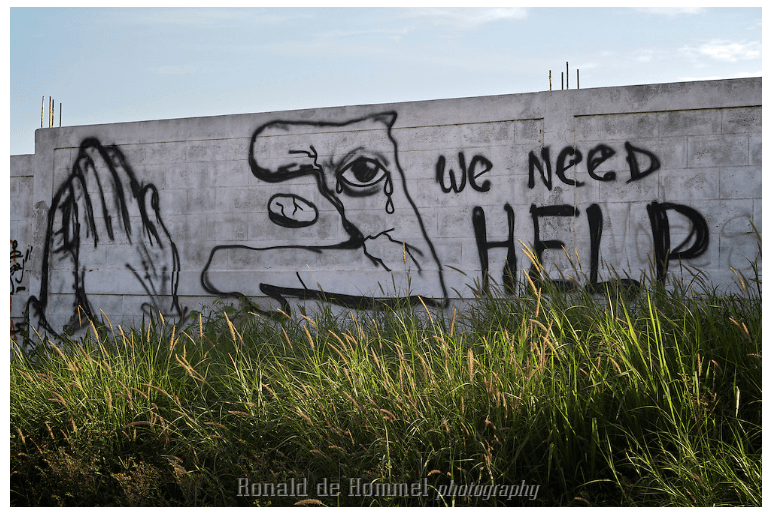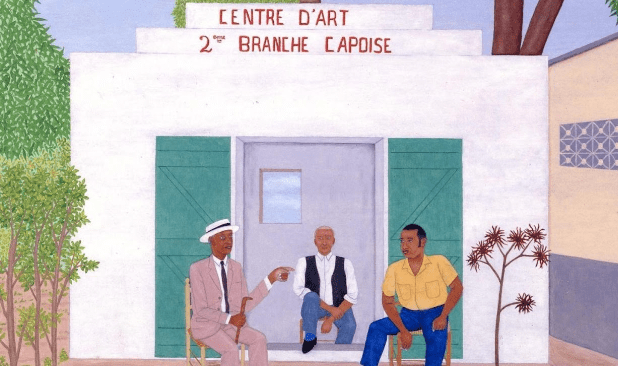As part of our course “Francophone Caribbean Culture and Society: Art, Music, and Cinema”, we dived into the rich history of Haitian art. Today, Haitian art is not only a powerful vehicle for expression and communication, but also a source of inspiration for Haiti’s future.
History of Art in Haiti
Where to start?
While it was only in 1944 that Dewitt Peters opened Haiti’s first art gallery, Le Centre d’Art, Haitian art dates back much further. Though painting and sculpting were heavily suppressed during the colonial era, other forms of art such as music and dance continued to serve as a unifying force for the slaves of Saint-Domingue (“Haitian Art History”). Even before the colonial era, Haitian art was an integral part of life for the Taino natives. Their artwork took the form of cave drawings, painting on the sides of huts, and even body art. Unfortunately, however, no remnants of their artwork survive today as a result of the ruthless oppression of European colonizers (“Haitian Art”).
Fast-forwarding to the 19th century, two of Haiti’s former leaders, Henri Cristophe and Alexandre Pétion, shared an immense appreciation for the arts. As strong advocates of artistic development in Haiti, they invited European and American artists to Haiti to train Haitian artists (“Haitian Art”). Among these foreign artists, one in particular had a profound impact on the artistic ecosystem of Haiti: DeWitt Peters. An American watercolorist, Peters helped establish Haiti’s first art gallery, Le Centre d’Art, in 1944.
The creation of the Centre d’Art marked a pivotal point in the history of Haitian art, as it enabled the establishment of a market through which Haitian artists could gain recognition both at a local and international scale (“Haitian Art History”). Moreover, the Centre d’Art drove economic activity in the domain of art, which was in turn fueled by a growing tourism industry (Le Centre d’Art – Haïti). For a deeper dive into the Centre d’Art and its significance, we recommend this Google Arts and Culture thread. Peters also influenced the Haitian art scene in that he trained many Haitian artists who are recognized to this day as key figures in Haitian art history.
While Peters and the Centre d’Art certainly had a substantial influence on Haitian art, it is important to remember that the success, beauty, and uniqueness of Haitian art did not and do not in any way depend on the influence of this American individual or the establishment of this institution. As Michel-Rolph Trouillot, a professor in the Department of Anthropology at Johns Hopkins University, aptly puts, “The story that Haitians had to wait for Mr. Peters to discover their hidden talent is just one more story of arrogance” (“Haitian Art Before and After 1944”).
![Art Fig. 1. Haitian art history. [Top row, left to right]. Two examples of cave petroglyphs in Haiti, dating back to the Taino natives. [Bottom row, left to right] Haiti’s Centre d’Art, opened in 1944. First board meeting held at the Centre d’Art.](https://voices.uchicago.edu/vaeranda/files/2022/08/Screen-Shot-2022-08-19-at-9.19.21-AM.png)
Renowned Haitian Artists
Hector Hyppolite (1894-1948) is one of the most renowned Haitian artists. After training with Peters, he went on to produce an incredible collection of paintings. In addition to being an artist, Hyppolite was a Voodoo priest (houngan) (“Haitian Art History”). His art thus features voodoo influences, a theme common to Haitian art.
In addition to Rigaud Benoit (1911-1986), other renowned artists include Philomé Obin (1892-1986). While the Centre d’Art was opened in Port-au-Prince, branches were opened across Haiti in later years. Obin headed one of these branches, which came to be known as “The Cape School” (Le Centre d’Art – Haïti). There, Philomé Obin spearheaded the Primitivism art movement in Haiti (discussed in more detail below).
![Fig. 2. Hector Hyppolite and selections of his artwork. [Top row, left to right]. Damballah La Flambeau. Maitresse Erzulie. Flowers on Table. [Bottom row, left to right] Portrait of Hector Hyppolite. Saint Francis and the Infant Jesus.](https://voices.uchicago.edu/vaeranda/files/2022/08/Screen-Shot-2022-08-19-at-9.20.27-AM.png)
![Fig. 3. Philomé Obin and selections of his artwork. [Top row, left to right]. Paysans sur la route. Portrait of Philomé Obin. [Bottom row] Philomé, Sénéque and Antoine Obin seated.](https://voices.uchicago.edu/vaeranda/files/2022/08/Screen-Shot-2022-08-19-at-9.21.17-AM.png)
What does Haitian Art Look Like?
Haitian art is everywhere! You don’t need to go to a museum to experience the abundance of Haitian artwork. You can appreciate the craftsmanship just by walking through the streets of this beautiful nation. Artwork can be found in stalls along the road, on concrete walls as murals and graffiti, and even on public transportation. Haiti has a system of buses, called tap taps, that are often decorated with vivid colors, slogans, and paintings of celebrities.
Haitian art is incredibly diverse, and spans a wide range of mediums. Paintings are brightly colored and depict daily life, Haitian culture, and history. Many artists infuse their works with the joy of the Haitian spirit. Unique to Haitian art are beaded flags. These fabric pieces are adorned with sequins and beads which are sewn into intricate designs that commemorate Vodou saints and spirits. Even recycled items, like steel drums, are given a new life as sculptures or ornate metalwork. In addition to art made for aesthetic purposes, Haitian artists make beautiful art pieces that serve as functional items. Haitian people don their heads with elaborately woven straw hats, and woven baskets are carried by many. Art is integrated into Haitian life, and it is reflective of the beauty of the land, the richness of the culture, and the resilient spirit of Haitians. Amidst a national history that is strife with hardship, the art transcends this narrative by showcasing the liveliness and pride of the people.
![Fig 4. Examples of Haitian art. [Top row] One of the vibrant tap tap buses that can be found driving through the streets of Haiti. [Bottom row, left to right] Haitian art lining the street. A beaded Haitian Vodou flag.](https://voices.uchicago.edu/vaeranda/files/2022/08/Screen-Shot-2022-08-19-at-9.22.15-AM.png)
Art as a Means of Communication, Expression, and Change
Haitian artists focus not only on the aesthetics (physical appearance) of the art itself, but on the messages or cultural narratives they wish to convey. Haitian artworks are frequently the preservers of rural Haitian culture, the politically-conscious voice speaking against Haiti’s misery and poor living conditions, or the vessel through which Haitian beauty can be portrayed. Other themes depicted include daily life in urban Haiti, religion (Christianity as well as Voodoo), and Haitian history. Thus, Haitian art reveals a certain level of historical awareness regarding Haiti’s past as well as a contemporary awareness of the present state of the nation amongst Haitian artists.
One example of the political range of Haitian art is the oeuvre of Jerry Rosembert Moise, a graffiti artist who gained notoriety after the 2010 earthquake. Jerry views Haiti as the ideal space for graffiti due to the obvious social inequality evident in historical as well as contemporary Haiti. Several of his works include depictions of Haiti painted with a sometimes teary eye. This display communicates the emotive human side behind the international narratives which display the poverty and need of Haiti. On further reflection, Haiti’s teary eye can be symbolized as a call for change and a better day in the nation.

What Makes Haitian Art Unique?
Thus, we can use these incredible facets of Haitain art to draw conclusions about what makes Haitian art unique, both in and of itself in its own features, and as a subset of Haitian culture.
As we have seen, the artwork of Haitian artists carries a pattern of uniqueness among each artist, as well as a trend in the messages behind the art. The art pieces are not random nor meaningless- they are all intricately unique, and carry statements about Haitian identity, culture, and people. Often, as with the work of Hyppolite, they may be inspired by Voudou, a religion rooted in Haitian culture since its revolution which continues to inspire Haitian people, while serving as a staple of tradition, to this day. Haitian art has not lost its meaning over time, but rather has continued to evolve with the times, maintaining its ties to, and uses of, cultural and religious inspiration. We see with the more modern graffiti art of Jerry, poignant social and political messages are conveyed on walls and street overpasses, often utilizing images of the Haitain flag and human suffering to invoke emotion in the viewer.
Haitian art is also unique in that it manages to be meaningful, yet omnipresent, at the same time. Art is everywhere in Haiti, from the “useful art,” such as woven baskets and basins, to the crafts and sculptures made of recycled materials, to the art in the museum, to the art on the tap-taps, art is everywhere you look. One might think that art, being in such plentiful supply in Haiti, would come to lose its value, but this is not true. For Haitians, art is a vehicle which is encouraged, a medium to convey national pride and be utilized in society to bring people together and advocate for common themes, while drawing inspiration brilliantly from cultural staples and iconic images, such as those of the flag or racial oppression. In its ability to be ubiquitous yet unique, omnipresent but meaningful, socially poignant yet universally encouraged, Haitian art is truly a one of a kind art form, and art culture, of its own.
This text was written by Kenley Ambroise, Cristina Gaudio, Danielle Mishler, and Kaela Jolibois as part of the work for the course KREY216 “Francophone Caribbean Culture and Society: art, Music, and Cinema” taught by Dr. Gerdine Ulysse.
Citations:
Salomon, M. N. (2021, May 12). Haitian art – what makes art in Haiti so special? Myriam Nader Haitian Art Gallery. Retrieved April 21, 2022, from https://www.naderhaitianart.com/blogs/news/what-makes-art-in-haiti-so-special
“Haitian Art.” Hougansydney.com, http://hougansydney.com/haitian-art.php.
“Haitian Art History.” Haitian Paintings, https://haitianartpaintings.com/haitian-art-history/.
Haitian Art Before and After 1944 and DeWitt Peters. http://faculty.webster.edu/corbetre/haiti/art/pre-1944.htm.
Le Centre d’Art – Haïti. “Le Centre D’Art.” Google Arts & Culture, https://artsandculture.google.com/story/dAVhQwjmxi1tJA.

